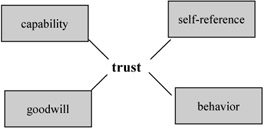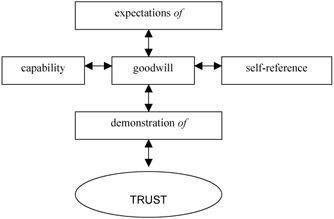Components of Trust
|
Researchers have given different meanings to trust, and in many cases trust has not been defined very clearly. Inconsistent and incomplete conceptualization leads to problems in operationalization and measurement. In a review of 30 empirical research chapters on trust in inter-organizational relationships in 1990–1999 (Blomqvist, Sundqvist & Soininen, 2002), it was found that there is still quite a lot of discrepancy in the conceptualization and operationalization of trust. Already the different disciplinary backgrounds of the authors (social psychology, economics, marketing, and philosophy) may raise some barriers for different researchers to discuss and their research to be compared. Also, semantics seems to raise misunderstandings, as different authors use quite different constructs to conceptualize trust, e.g., hope, faith, loyalty and credibility (see Blomqvist, 1997).
For the context of asymmetric technology partnerships, based on an extensive literature analysis, Blomqvist (1997) has defined trust as the "actor's expectation of the other party's competence and goodwill." This definition includes the dimensions of competence (i.e., technological capabilities, skills and know-how) and the more abstract goodwill, which implies moral responsibility and positive intentions toward the other. It could be assumed that competence is a necessary antecedent for trust in the business context, especially in technology partnerships, where complementary technological knowledge and competencies are a key motivation for partnership formation (Blomqvist, 2002). Also, Sako (1998), Sako and Helper (1998) and Noteboom (1997) have included competence in their definition of trust. However, signs of goodwill and the related expectation of the partner's positive intentions are also necessary for a partner to be able to accept risk and a potentially vulnerable position. It is assumed that a businessman would not enter into a partnership without a reasonable understanding of the partner's goodwill.
In further research Blomqvist (2002) has used interviews of business practitioners from large and small companies, representing operative and strategic organizational levels, in order to look deeper into the conceptualization of trust in a dynamic environment. The components of trust were formed through interviews based on open-ended questions: How do you evaluate your partner? What characteristics do you find important? What do you tell and highlight about you and your company when presenting yourself to a potential partner? The quotes in this article are drawn from these in-depth interviews.
The large firm managers, small firm managing directors and other key persons who were interviewed very clearly saw trust to be critical for partnering. The interviews confirmed the two components of trust — capability and goodwill — that were also brought up in the literature review.
"That trust comes automatically in a certain way there. First you appreciate the other person's knowledge and the other person also appreciates your knowledge and experience…the basic rule is how you treat those people. Remember to honor them." (Manager, Large ICT Company A)
"Goodwill is the motivation in a certain way…it is the power setting the motion. It is our way, it is not only what I say, but it is our way to operate…We would lose our good brand quite fast if we behaved opportunistically; even when we have the chance to do so. But this is not so shortsighted. If we plan to operate somewhere, we need to operate ethically correct." (Manager, Large ICT Company A)
"Me and my boss helped people at Net to ask the right questions and present the right things, as we knew what we wanted and what they could deliver…They had worked hard for us and we wanted to help them." (Project manager, Large ICT Company E)
However, the interviews included many viewpoints that could not be labeled under competence or goodwill, but dealt often with the other party's behavior, e.g., what really happened in the cooperation.
"[Trust is] To act as the other party expects you to act, taking into consideration what you have done and said…when the other party knows what you have done and what you have said. It is not only the word but how you have acted and done in similar situations. It has to be predictable…Trust emerges more from behavior. If you have done well then you know that you have created trust. I don't think that an attempt to create trust could be any point of departure. Trust emerges from what you have done, how you have acted." (Director, Large ICT Company A)
In addition, the interviewees repeatedly presented viewpoints that dealt with the impressions of the image, brand or vision of the other party.
"Trust in a large firm is about the image and brand. I have worked things through with large corporations. It is great to go to a world top company; you have a different attitude for such. But then again, when the meeting, discussion and cooperation get going, it (trust) changes again for that individual. You need to find the people who keep the cooperation going. But in the beginning, the reputation may bring trust." (Managing director, Internet Technology Next)
"I evaluate a potential partner with feelings anyway. It is the first couple of minutes...The first impression is important...how they present themselves, whether they are really interested, and whether they have a vision. I also look whether they are able to communicate their vision and have self-respect. It is the feeling…Yes, I don't know if I should have, but I don't have any systematic way of evaluating them. You listen to their story and evaluate whether it is credible or not." (Partner director, Large ICT Company B)
As a result of the analyses of all the perspectives of the interviewees, two new components of trust were included: behavior and self-reference.
Already at the very first meetings, the behavioral dimension of trust is present in signs and signals, e.g., what information is revealed and in which manner. Signs of goodwill are necessary for the trusting party to be able to accept a potentially vulnerable position. Through the partnering process (along time) the actual behavior, e.g., kept promises, become more visible and easier to evaluate.
In technology partnerships, the individuals and organizations can be referred to as self-referential, if they are aware of their identity, capabilities and values. Thus, they have a strong individual or corporate identity [1] and related self-confidence (self-definition and self-regulation of boundaries).
"First (when introducing your company to a potential partner) you need to have focused your business so that the other party understands that and sees it clearly. Then they can see my role, my firm's role and how we and they will work together…and what they need and can get from my company." (Managing director, Small Software Company Alpha)
The concept of trust includes four components - capability, goodwill, behavior, and self-reference — based on which we can understand the nature of trust to a certain extent (Figure 1).

Figure 1: Preliminary Model of the Components of Trust
However, this kind of conceptualization is only a starting point, because the components are not comparable with each other, they include a variety of perspectives and, in addition, they do not necessarily reveal much about the dynamics of trust building. However, we argue that understanding the components is useful, because they illustrate the dimensions and interfaces of trust.
As a more dynamic approach — based on both the interviews and the literature — we point out activities that are important in trust building: expectation and demonstration, e.g., the internal activity and external activity of the actors. Trust is always created in a dynamic way. It is either increasing or decreasing, and we can never treat it like a static entity in a relationship. In addition, trust is very fragile: building it up can take a long time, but breaking it down may occur in a second.
To come a step closer to understanding trust as a phenomenon, we define the basic dynamics of trust by interaction between the parties' expectations of each other and demonstration of those expectations in their actual behavior. The expectations concern mainly the capability, goodwill and self-reference of the other party, as well as their demonstration in the partner's behavior (St hle & Laento, 2000). A preliminary model of the dynamics of trust is illustrated in Figure 2.

Figure 2: Preliminary Model of the Dynamics of Trust
In the context of partnership formation, we can conclude:
Trust is an actor's expectation of the other party's capability, goodwill and self-reference, which needs to be confirmed by experience. Thus, trust is increased by — and decreased by the lack of — evidence of these components in parties' actual behavior and communication.
[1]Metcalfe and James (2001, 48) discuss a firm's self-image as a critical factor in interfirm cooperation and knowledge transfer leading to more or less easy retaining of their distinctive identities.
|
EAN: 2147483647
Pages: 143